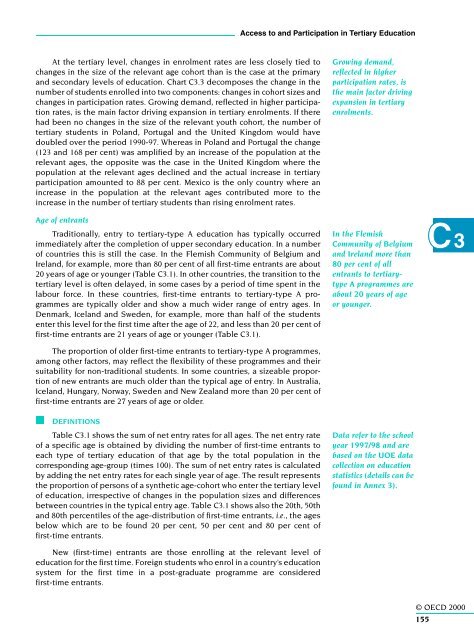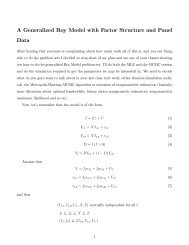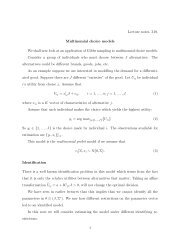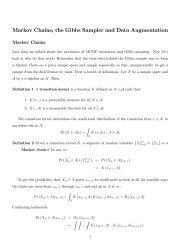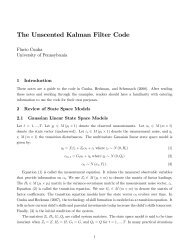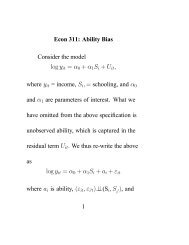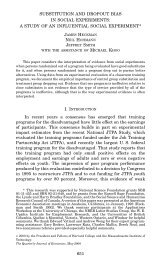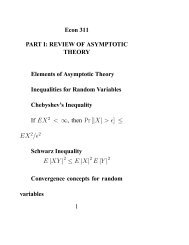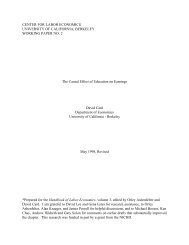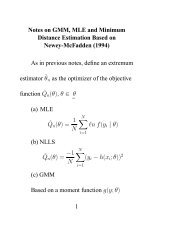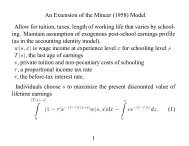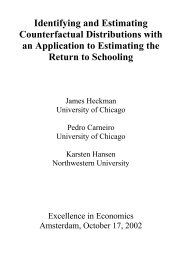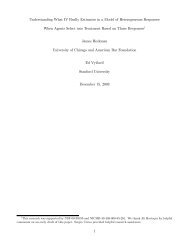OECD (2000)
OECD (2000)
OECD (2000)
You also want an ePaper? Increase the reach of your titles
YUMPU automatically turns print PDFs into web optimized ePapers that Google loves.
Access to and Participation in Tertiary Education<br />
At the tertiary level, changes in enrolment rates are less closely tied to<br />
changes in the size of the relevant age cohort than is the case at the primary<br />
and secondary levels of education. Chart C3.3 decomposes the change in the<br />
number of students enrolled into two components: changes in cohort sizes and<br />
changes in participation rates. Growing demand, reflected in higher participation<br />
rates, is the main factor driving expansion in tertiary enrolments. If there<br />
had been no changes in the size of the relevant youth cohort, the number of<br />
tertiary students in Poland, Portugal and the United Kingdom would have<br />
doubled over the period 1990-97. Whereas in Poland and Portugal the change<br />
(123 and 168 per cent) was amplified by an increase of the population at the<br />
relevant ages, the opposite was the case in the United Kingdom where the<br />
population at the relevant ages declined and the actual increase in tertiary<br />
participation amounted to 88 per cent. Mexico is the only country where an<br />
increase in the population at the relevant ages contributed more to the<br />
increase in the number of tertiary students than rising enrolment rates.<br />
Age of entrants<br />
Traditionally, entry to tertiary-type A education has typically occurred<br />
immediately after the completion of upper secondary education. In a number<br />
of countries this is still the case. In the Flemish Community of Belgium and<br />
Ireland, for example, more than 80 per cent of all first-time entrants are about<br />
20 years of age or younger (Table C3.1). In other countries, the transition to the<br />
tertiary level is often delayed, in some cases by a period of time spent in the<br />
labour force. In these countries, first-time entrants to tertiary-type A programmes<br />
are typically older and show a much wider range of entry ages. In<br />
Denmark, Iceland and Sweden, for example, more than half of the students<br />
enter this level for the first time after the age of 22, and less than 20 per cent of<br />
first-time entrants are 21 years of age or younger (Table C3.1).<br />
The proportion of older first-time entrants to tertiary-type A programmes,<br />
among other factors, may reflect the flexibility of these programmes and their<br />
suitability for non-traditional students. In some countries, a sizeable proportion<br />
of new entrants are much older than the typical age of entry. In Australia,<br />
Iceland, Hungary, Norway, Sweden and New Zealand more than 20 per cent of<br />
first-time entrants are 27 years of age or older.<br />
Growing demand,<br />
reflected in higher<br />
participation rates, is<br />
the main factor driving<br />
expansion in tertiary<br />
enrolments.<br />
In the Flemish<br />
Community of Belgium<br />
and Ireland more than<br />
80 per cent of all<br />
entrants to tertiarytype<br />
A programmes are<br />
about 20 years of age<br />
or younger.<br />
C3<br />
DEFINITIONS<br />
Table C3.1 shows the sum of net entry rates for all ages. The net entry rate<br />
of a specific age is obtained by dividing the number of first-time entrants to<br />
each type of tertiary education of that age by the total population in the<br />
corresponding age-group (times 100). The sum of net entry rates is calculated<br />
by adding the net entry rates for each single year of age. The result represents<br />
the proportion of persons of a synthetic age-cohort who enter the tertiary level<br />
of education, irrespective of changes in the population sizes and differences<br />
between countries in the typical entry age. Table C3.1 shows also the 20th, 50th<br />
and 80th percentiles of the age-distribution of first-time entrants, i.e., the ages<br />
below which are to be found 20 per cent, 50 per cent and 80 per cent of<br />
first-time entrants.<br />
New (first-time) entrants are those enrolling at the relevant level of<br />
education for the first time. Foreign students who enrol in a country’s education<br />
system for the first time in a post-graduate programme are considered<br />
first-time entrants.<br />
Data refer to the school<br />
year 1997/98 and are<br />
based on the UOE data<br />
collection on education<br />
statistics (details can be<br />
found in Annex 3).<br />
© <strong>OECD</strong> <strong>2000</strong><br />
155


